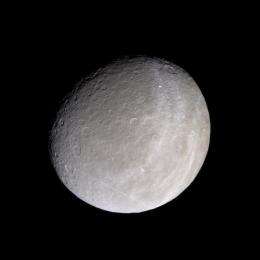November 26, 2010 report
Cassini finds oxygen-carbon dioxide atmosphere on Saturn's moon Rhea

(PhysOrg.com) -- In a flyby past Rhea, Saturn's second-largest moon, NASA's spacecraft Cassini has revealed the presence of a thin atmosphere of 70 percent oxygen and 30 percent carbon dioxide, which is apparently sustained by chemical decomposition of the moon’s ice-covered surface.
Scientists from the US, UK and Germany analyzing the data from Cassini say the presence of an oxidizing atmosphere is consistent with remote observations by the Hubble telescope and the Galileo probe of Jupiter’s icy moons Europa and Ganymede, but this is the first time the presence of oxygen has been detected directly on any moon or planet.
Rhea is a mere 1,500 kilometers in diameter and is always covered with a thick layer of water ice. The average surface temperature is estimated to be -180°C. The newly discovered oxygen and carbon dioxide atmosphere is only 100 kilometers thick, and is so thin that if it were at Earth-like pressures and temperatures, the entire atmosphere would fit snugly into a medium-sized building.
The oxygen is believed to be formed when water molecules are split by energetic particles in a process called radiolysis. The oxygen is then ejected into the atmosphere and is captured by Rhea’s gravity. The data suggests about 130 grams of oxygen per second is produced on Rhea. The carbon dioxide may originate in dry ice trapped inside the moon, or it could be from carbon-rich meteorites hitting the surface and split apart by charged particles in a similar way to the water ice. Another possibility is it could be escaping from the planet’s interior.
The moon is around 527,000 kilometers from Saturn and orbits within the magnetic field. It is radiation from this magnetosphere that is believed to cause the chemical breakdown of the ice on the surface and create the atmosphere.
Leader of the research team, Ben Teolis, from the Space Science & Engineering Division of the Southwest Research Institute at San Antonio, Texas, said the finding implies that oxygen atmospheres associated with irradiated icy moons may be common throughout the universe if the moon has sufficient mass to hold an atmosphere. He said the findings may also help scientists understand how and where oxygen is likely to exist, which will aid in the planning of future unmanned and manned space missions.
Cassini has been orbiting Saturn and its moons since 2004 and flew over Rhea at an altitude of 97 kilometers in March this year. Of Saturn’s moons only Rhea and Titan have enough mass to hold an atmosphere, but Titan’s atmosphere is mostly nitrogen and methane, with only minute amounts of oxygen and carbon dioxide.
The findings were published online on 25 November in the journal Science
More information: Cassini Finds an Oxygen–Carbon Dioxide Atmosphere at Saturn’s Icy Moon Rhea, Science, Published Online 25 November 2010. DOI:10.1126/science.1198366
© 2010 PhysOrg.com


















